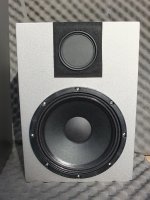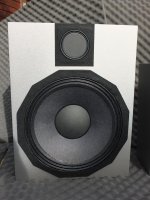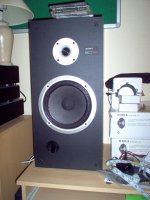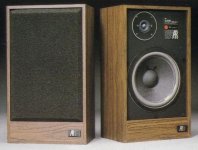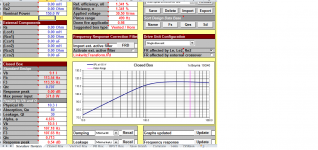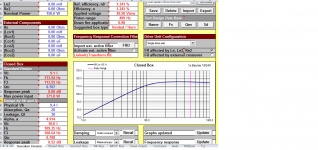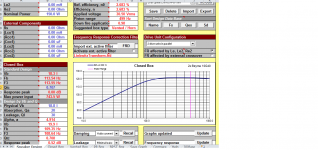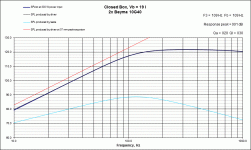Thanks for taking the time to do that!
An 18 liter sealed box returns a Q=0.5. Is 18 liter considered a really big box? Attached frequency response from UniBox. The 6dB down frequency is 80Hz.
Chart shows one 10G40 in an 18-liter sealed box driven at 75W, and reaching 106dB at 80Hz. The amp can deliver 300W cleanly (rated at 400W), and I was planning on two 10G40 per side. It seems I would have headroom in terms of power handling.
A 6.3 liter sealed box represents Q=0.71, and F3 is 121Hz, as you mentioned.
Where I get confused is when thinking what would happen if I used an LR4th order at 80Hz? Would it not work well, or would it be a lot more difficult to model?
Yeap, I'm aware of localization concerns. Plus my subs aren't all that comfortable above 80Hz, really. DIY Rythmik Audio Direct Servo 12" sealed 56L - Home Theater Forum and Systems - HomeTheaterShack.com
BTW, I have not yet decided on a midrange driver. I am planning to experiment with the 10G40s and later decide what midrange to use. I do know the tweeters will be TPL-150H, though.
I guess box size is subjective, your call. If you use a 4th order Linkwitz Riley at 80 Hz for the electrical high pass, and a second order Butterworth at 121 Hz for the box, it'll be some sort of 6th order high pass. It'll sum "weird" with your 4th order low pass sub. You'll end up with depressed output from 80 to 120Hz and its impossible to predict what will happen below 80Hz, you'd have to simulate it.
Maybe not the answer you want, but to figure out if these combos will work, you have to simulate them. Free tools can be had at:
Jeff Bagby's Software Page
If you want to follow post41 crossover philosophy, then you will need to add a Linkwitz Transform.
One must have the equivalent to two cascaded Butterworth at the SAME frequency.
The LT allows one to adjust the box size and the box Q to achieve the required Butterworth to enable the LR4 filter.
One must have the equivalent to two cascaded Butterworth at the SAME frequency.
The LT allows one to adjust the box size and the box Q to achieve the required Butterworth to enable the LR4 filter.
You explained that well AndrewT. The electronics protects the bass from excessive excursion. A subsonic bass filter in effect. We did electrical filtering of a novel B&W reflex speaker a while back. The idea was the additional box of electronics was a steep second order filter and it ended up BW6. Like DSP really.
Just to make clear that Overdamped refers to a box bigger than Q=0.71 optimum. Underdamped is a box smaller than optimum. For Qts=0.38 optimum reflex it is the Vas. It is also the Vas for Qts=0.5 drivers in closed box.
Anyway, here's some steeper Butterworth slopes of increasing order, and some pole-zero diagrams of what you can do. For shallow BW2, the -3dB point F3 is considered to be Fo, that is the radius of the circle or the Fs. For this Beyma 10G40 driver 55Hz IIRC and the reflex is about BW4.
You can see that two BW2 filters in succession make a LR4. Because you just add the poles.
Hope the images are interesting. Pole-Zero analysis is quite high level maths, called function of a complex variable. 🙂
Thanks Steve.
I'm struggling to understand the two drawings you attached. What does the circle represent? You add a filter with a given Q (probably the one from the box) to another filter (probably the electrical), and show a result. What do the crosses and their locations represent?
I'm generally comfortable with math, BTW.
If you want to follow post41 crossover philosophy, then you will need to add a Linkwitz Transform.
That's a good idea but it may eat up to half the amp power. I still think the best option is using a mid-woofer that gives a sealed box Butterworth at 80Hz. I do very nearly that with the Scan 8545
Pole-Zero analysis is quite hard, don't worry about it. FWIW, the lower diagram shows how you add BW2 closed box to a BW2 subsonic electrical filter to get LR4. BW4 is your typical reflex response.

I looked up the Beyma 10G40 woofer:
LOW & MID FREQUENCY 10G40 | Beyma
Vas 45L (=1.6 cu feet IIRC)
Qts 0.3
Fs 45 Hz
Optimal closed box for 0.71 Qc is 11L. That's ridiculously small, because this is actually a reflex driver. I think I showed some suggested 1.5 and 3 cu feet reflex designs. It's about right. Closed box calculations are here:
http://www.diyaudio.com/forums/diyaudio-com-articles/158899-arpeggio-loudspeaker.html
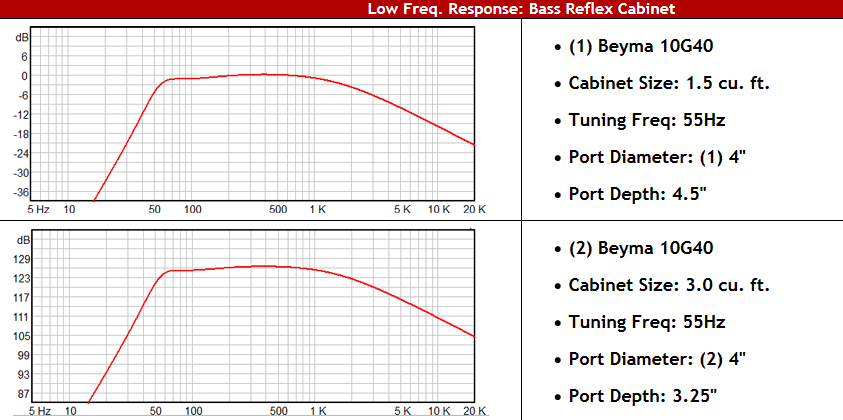
To lower the bass excursion problems below 55Hz and to be able to drive these speakers hard, you want to apply a subsonic filter coming in around 55Hz. I wouldn't lose too much sleep over getting it exactly right. Just have a listen.

I looked up the Beyma 10G40 woofer:
LOW & MID FREQUENCY 10G40 | Beyma
Vas 45L (=1.6 cu feet IIRC)
Qts 0.3
Fs 45 Hz
Optimal closed box for 0.71 Qc is 11L. That's ridiculously small, because this is actually a reflex driver. I think I showed some suggested 1.5 and 3 cu feet reflex designs. It's about right. Closed box calculations are here:
http://www.diyaudio.com/forums/diyaudio-com-articles/158899-arpeggio-loudspeaker.html

To lower the bass excursion problems below 55Hz and to be able to drive these speakers hard, you want to apply a subsonic filter coming in around 55Hz. I wouldn't lose too much sleep over getting it exactly right. Just have a listen.
Last edited:
That means he has to throw away the speaker he wants to use and find a new speaker that gives 80Hz when in the Butterworth size box.That's a good idea but it may eat up to half the amp power. I still think the best option is using a mid-woofer that gives a sealed box Butterworth at 80Hz. I do very nearly that with the Scan 8545
He does not want to do that.
The LT may have to apply a lot more than 3dB correction (throw away half the power, as you put it).
It could be 6dB to 10dB of correction and that means applying 4 to 10 times the power to the driver in an attempt to use the "too small" speaker at the too low frequency.
Last edited:
Sealed box, accurate nearfield studio monitor
I have been working on a a range of two way active monitors and come up with SAM, MAM, and LAM....Small active monitor, medium active monitor and large active monitor....Attached is the SAM with a 10 inch bass mid (OEM'd to suit my needs), I will post a pic of LAM with my 15 inch bass/mid...Still working on MAM!
My designs are different as they use a 300Hz crossover to the mid / top driver (my own design of BMR) so they will only be of limited interest when using a conventional 1KHz to 3KHz crossover point.
A few additional caveats:
I only design with active amplification and DSP crossovers with steep ish slopes (48dB to 60dB per octave)
I always use Eq to tune the frequency response.
I place a huge amount of emphasis on time domain accuracy and much less on frequency response as I can Eq (in the studio or anechoic) the FR to plus minus 2dB over 150Hz to 15KHz.
But subject to the above I might be able to help save you some time and effort with some general advice.....:
(1) Use the max desired SPL in the mid and top to as the reference for your bass / low midrange performance. For example a SAM might require 96dB continuous with 102dB peaks at 1 meter as a rough guide.
(2) Select a bass / mid capable of matching the SPL at your desired bass cut off without exceeding Xmax or its thermal limit.
(3) IMO if any bass / mid has to move more than plus / minus 6mm you need to use a bigger driver or more of the same driver.....Minimise cone movement at all costs....Less is ALWAYS more!!
(4) I only ever use sealed box for any and all driver loading....I have even abandoned open baffle!
(5) I believe a Q of 0.707 is the all round best compromise in most cases.
(6) NEVER use any driver with a rubber surround.....Only linen, cotton, silk or a combination of these materials.
(7)The only TS parameters I look for are a good "fast" driver ie Low Mms and high Bl. High power handling is very important but huge XMax is a waste of time.....Whether or not a driver can do plus minus 10mm or 12mm Xmax, I never ask a driver to do this....Better to observe point 3 above.
(8) As a rule of thumb, in order to get the -3dB point bass response down to 45Hz (SAM) 6.5 and 8 inch drivers need a min 2 inch voice coil, 10 inch driver needs 3 inch VC to reach 38Hz (SAM), a 12 inch driver needs 4 inch VC to reach 30Hz (MAM) and 15 inch driver a 4 inch or 5 inch VC to reach around 20Hz (LAM) handle the power after Eq'ing the low end in a small sealed box design.
I hope the above helps and all the best
Derek.
Hi guys,
I'm ready to design the enclosure of my 2-way active monitor. Now I have to decide the size... I know the Q matter has been widely discussed, but please let me start from the following assumptions:
1)sealed enclosure
2)enclosure volume is no design constraint
3)bass roll-off can be digitally EQd through linear phase FIR filters
4)max SPL is no object
Which Q would you choose in order to get the best overall sound quality?
I have been working on a a range of two way active monitors and come up with SAM, MAM, and LAM....Small active monitor, medium active monitor and large active monitor....Attached is the SAM with a 10 inch bass mid (OEM'd to suit my needs), I will post a pic of LAM with my 15 inch bass/mid...Still working on MAM!
My designs are different as they use a 300Hz crossover to the mid / top driver (my own design of BMR) so they will only be of limited interest when using a conventional 1KHz to 3KHz crossover point.
A few additional caveats:
I only design with active amplification and DSP crossovers with steep ish slopes (48dB to 60dB per octave)
I always use Eq to tune the frequency response.
I place a huge amount of emphasis on time domain accuracy and much less on frequency response as I can Eq (in the studio or anechoic) the FR to plus minus 2dB over 150Hz to 15KHz.
But subject to the above I might be able to help save you some time and effort with some general advice.....:
(1) Use the max desired SPL in the mid and top to as the reference for your bass / low midrange performance. For example a SAM might require 96dB continuous with 102dB peaks at 1 meter as a rough guide.
(2) Select a bass / mid capable of matching the SPL at your desired bass cut off without exceeding Xmax or its thermal limit.
(3) IMO if any bass / mid has to move more than plus / minus 6mm you need to use a bigger driver or more of the same driver.....Minimise cone movement at all costs....Less is ALWAYS more!!
(4) I only ever use sealed box for any and all driver loading....I have even abandoned open baffle!
(5) I believe a Q of 0.707 is the all round best compromise in most cases.
(6) NEVER use any driver with a rubber surround.....Only linen, cotton, silk or a combination of these materials.
(7)The only TS parameters I look for are a good "fast" driver ie Low Mms and high Bl. High power handling is very important but huge XMax is a waste of time.....Whether or not a driver can do plus minus 10mm or 12mm Xmax, I never ask a driver to do this....Better to observe point 3 above.
(8) As a rule of thumb, in order to get the -3dB point bass response down to 45Hz (SAM) 6.5 and 8 inch drivers need a min 2 inch voice coil, 10 inch driver needs 3 inch VC to reach 38Hz (SAM), a 12 inch driver needs 4 inch VC to reach 30Hz (MAM) and 15 inch driver a 4 inch or 5 inch VC to reach around 20Hz (LAM) handle the power after Eq'ing the low end in a small sealed box design.
I hope the above helps and all the best
Derek.
Attachments
Here is the LAM
15 inch low Mms very high(!) Bl, 4 inch voice coil, crossed over at 300Hz.
A couple of weeks ago I took a pair of these to a UK dealer with a very high end (£45K) vinyl based system with flagship Quad Electrostatics crossed over to massive subs, huge class A power amps, mega silver cables and fancy racks etc....
My £12K system consisted of:
Modest class A/B amps, my own prototype 4 channel DAC's & a DEQX using digi in / out and a lap top with JRiver running on an SSD driving my LAM speakers.....
Mark was stunned.....As good as his vinyl based set up was he was blown away....."The best digital he has ever heard" was one quote and "amazing bass" was another.....
I will be going back in a few months once our own DSP is ready....Plus by then we will have installed all our own power amps and refined the DAC's.
All the electronics will be installed on alloy back panel on the LAM's.
Just feed in your source and you are done.....
This system is going to scare the hell out of any system at £8K to £10K plus.....
15 inch low Mms very high(!) Bl, 4 inch voice coil, crossed over at 300Hz.
A couple of weeks ago I took a pair of these to a UK dealer with a very high end (£45K) vinyl based system with flagship Quad Electrostatics crossed over to massive subs, huge class A power amps, mega silver cables and fancy racks etc....
My £12K system consisted of:
Modest class A/B amps, my own prototype 4 channel DAC's & a DEQX using digi in / out and a lap top with JRiver running on an SSD driving my LAM speakers.....
Mark was stunned.....As good as his vinyl based set up was he was blown away....."The best digital he has ever heard" was one quote and "amazing bass" was another.....
I will be going back in a few months once our own DSP is ready....Plus by then we will have installed all our own power amps and refined the DAC's.
All the electronics will be installed on alloy back panel on the LAM's.
Just feed in your source and you are done.....
This system is going to scare the hell out of any system at £8K to £10K plus.....
Attachments
I only design with active amplification and DSP crossovers with steep ish slopes (48dB to 60dB per octave)
I always use Eq to tune the frequency response.
I place a huge amount of emphasis on time domain accuracy and much less on frequency response as I can Eq (in the studio or anechoic) the FR to plus minus 2dB over 150Hz to 15KHz.
But subject to the above I might be able to help save you some time and effort with some general advice.....:
(1) Use the max desired SPL in the mid and top to as the reference for your bass / low midrange performance. For example a SAM might require 96dB continuous with 102dB peaks at 1 meter as a rough guide.
(2) Select a bass / mid capable of matching the SPL at your desired bass cut off without exceeding Xmax or its thermal limit.
(3) IMO if any bass / mid has to move more than plus / minus 6mm you need to use a bigger driver or more of the same driver.....Minimise cone movement at all costs....Less is ALWAYS more!!
(4) I only ever use sealed box for any and all driver loading....I have even abandoned open baffle!
(5) I believe a Q of 0.707 is the all round best compromise in most cases.
(6) NEVER use any driver with a rubber surround.....Only linen, cotton, silk or a combination of these materials.
(7)The only TS parameters I look for are a good "fast" driver ie Low Mms and high Bl. High power handling is very important but huge XMax is a waste of time.....Whether or not a driver can do plus minus 10mm or 12mm Xmax, I never ask a driver to do this....Better to observe point 3 above.
(8) As a rule of thumb, in order to get the -3dB point bass response down to 45Hz (SAM) 6.5 and 8 inch drivers need a min 2 inch voice coil, 10 inch driver needs 3 inch VC to reach 38Hz (SAM), a 12 inch driver needs 4 inch VC to reach 30Hz (MAM) and 15 inch driver a 4 inch or 5 inch VC to reach around 20Hz (LAM) handle the power after Eq'ing the low end in a small sealed box design.
I hope the above helps and all the best
Derek.
Hi Derek.
Glad to see you join. It's valuable to me to have an informed opinion from someone who uses DSP extensively, as I also plan to do.
My choice of two Beyma 10G40 per side comply 100% with ALL your points above. Hopefully a good start!
To make sure I understand: in case like mine, where I have a sealed subwoofer up to 80Hz and the 10G40 from there on, would you build a Qtc=0.71 sealed box for the 10G40 and apply high order (4 or 5-order) electronic xo, and further apply DSP to shape the frequency response to what you want?
Pole-Zero analysis is quite hard, don't worry about it. FWIW, the lower diagram shows how you add BW2 closed box to a BW2 subsonic electrical filter to get LR4. BW4 is your typical reflex response.

I looked up the Beyma 10G40 woofer:
LOW & MID FREQUENCY 10G40 | Beyma
Vas 45L (=1.6 cu feet IIRC)
Qts 0.3
Fs 45 Hz
Optimal closed box for 0.71 Qc is 11L. That's ridiculously small, because this is actually a reflex driver. I think I showed some suggested 1.5 and 3 cu feet reflex designs. It's about right. Closed box calculations are here:
http://www.diyaudio.com/forums/diyaudio-com-articles/158899-arpeggio-loudspeaker.html

To lower the bass excursion problems below 55Hz and to be able to drive these speakers hard, you want to apply a subsonic filter coming in around 55Hz. I wouldn't lose too much sleep over getting it exactly right. Just have a listen.
Hello Steve.
Thanks for the feedback. I guess I don't know enough to have perspective: what's the consecuence of using a reflex driver like the 10G40 in a sealed box? Any advantages? Disadvantages?
Thank you!
spot on
Totally correct!
Cheers
Derek.
Hi Derek.
Glad to see you join. It's valuable to me to have an informed opinion from someone who uses DSP extensively, as I also plan to do.
My choice of two Beyma 10G40 per side comply 100% with ALL your points above. Hopefully a good start!
To make sure I understand: in case like mine, where I have a sealed subwoofer up to 80Hz and the 10G40 from there on, would you build a Qtc=0.71 sealed box for the 10G40 and apply high order (4 or 5-order) electronic xo, and further apply DSP to shape the frequency response to what you want?
Totally correct!
Cheers
Derek.
Totally opposite....
With all due respect to system 7 who I am sure is great guy who loves music and is only trying to help ..... I totally disagree with all of the above....!
Plus I disagree with the "default" thinking that is repeated 1,000 fold by all the traditional thinking "loudspeaker design cookbook" and the other old school text books dating back 50 years and more....
Why? How? ....???
I have attached a simulation of the 10G40, Whilst I havn't used this driver and been able to compare real world results with the sim I have found this simulation very accurate with other drivers.
What is not very accurate is the plus / minus 10% or even 15% manufacturing tolerance of many manufacturers.
One of the main advantages of going OEM is the ability to specify tolerance, all be it at a £££.
Anyway, the reality is all the old school thinking as described above, is a million miles away from the best solution.
Back when this theory was valid, power amps were expensive, materials science & voice coil design had not advanced to thermally resistant adhesives, Kevlar, nomex, advanced damping compounds, cone manufacturing and precision VC windings with power cooling....Never mind high power Neo motors, carbon fibre and computer modeling / FEA / and thermal probes....
Using all the software and usual suspects of EBP, TS calculations etc etc the Beyma 10G40 is classed as a reflex design....
Yet I can pop it in tiny (10.7 litre) sealed box with a perfect 0.707 Q and get fantastic bass which is vastly superior to any ported / transmission line / BLH time domain wrecked loading....I save on space, materials and have maximum reliability and great performance....Eq'd to perfection and room tuned to allow for different locations/ listening positions and preferences.
Forget all passive crossovers traditional delayed resonance loading....they all suck....& blow, but they do it out of phase.....! I will attach a John Wilkinson paper which explains this in more detail in the next post.
I hope some of this raises a few eye brows ...Its long overdue!
All the best and all in good faith.
Cheers
Derek.
Pole-Zero analysis is quite hard, don't worry about it. FWIW, the lower diagram shows how you add BW2 closed box to a BW2 subsonic electrical filter to get LR4. BW4 is your typical reflex response.

I looked up the Beyma 10G40 woofer:
LOW & MID FREQUENCY 10G40 | Beyma
Vas 45L (=1.6 cu feet IIRC)
Qts 0.3
Fs 45 Hz
Optimal closed box for 0.71 Qc is 11L. That's ridiculously small, because this is actually a reflex driver. I think I showed some suggested 1.5 and 3 cu feet reflex designs. It's about right. Closed box calculations are here:
http://www.diyaudio.com/forums/diyaudio-com-articles/158899-arpeggio-loudspeaker.html

To lower the bass excursion problems below 55Hz and to be able to drive these speakers hard, you want to apply a subsonic filter coming in around 55Hz. I wouldn't lose too much sleep over getting it exactly right. Just have a listen.
With all due respect to system 7 who I am sure is great guy who loves music and is only trying to help ..... I totally disagree with all of the above....!
Plus I disagree with the "default" thinking that is repeated 1,000 fold by all the traditional thinking "loudspeaker design cookbook" and the other old school text books dating back 50 years and more....
Why? How? ....???
I have attached a simulation of the 10G40, Whilst I havn't used this driver and been able to compare real world results with the sim I have found this simulation very accurate with other drivers.
What is not very accurate is the plus / minus 10% or even 15% manufacturing tolerance of many manufacturers.
One of the main advantages of going OEM is the ability to specify tolerance, all be it at a £££.
Anyway, the reality is all the old school thinking as described above, is a million miles away from the best solution.
Back when this theory was valid, power amps were expensive, materials science & voice coil design had not advanced to thermally resistant adhesives, Kevlar, nomex, advanced damping compounds, cone manufacturing and precision VC windings with power cooling....Never mind high power Neo motors, carbon fibre and computer modeling / FEA / and thermal probes....
Using all the software and usual suspects of EBP, TS calculations etc etc the Beyma 10G40 is classed as a reflex design....
Yet I can pop it in tiny (10.7 litre) sealed box with a perfect 0.707 Q and get fantastic bass which is vastly superior to any ported / transmission line / BLH time domain wrecked loading....I save on space, materials and have maximum reliability and great performance....Eq'd to perfection and room tuned to allow for different locations/ listening positions and preferences.
Forget all passive crossovers traditional delayed resonance loading....they all suck....& blow, but they do it out of phase.....! I will attach a John Wilkinson paper which explains this in more detail in the next post.
I hope some of this raises a few eye brows ...Its long overdue!
All the best and all in good faith.
Cheers
Derek.
Attachments
Last edited:
Ports / transmission lines....Elephant in the room!
This is a few years old.
Despite the best efforts of many old school manufacturers and DIY guys who huff and puff ( just like their loudspeakers!) to try and discredit the attached, it is fact not fiction.
All the best
Derek.
This is a few years old.
Despite the best efforts of many old school manufacturers and DIY guys who huff and puff ( just like their loudspeakers!) to try and discredit the attached, it is fact not fiction.
All the best
Derek.
Attachments
Totally correct!
Cheers
Derek.
lewinksi.
If you go this route, make sure you have enough amp power to reach the sound pressure levels you want.
The benefit of the "old school" approach is that it matches your speaker to the amplifier to maximize it's performance.
2nd order Butterworth 80hz box alignment + 2nd order high pass in the dsp at 80Hz + DSp clean up, will play louder with a given amp below 120 Hz than 2nd order Butterworth 120hz box alignment + DSP clean up
Here's two ways of using a reflex diver, ie Qts 0.3 and Vas of 49L and Fs of 45Hz.
We could use it Acoustic Research style in a tiny but neat 10L. Like the (nice) AR18S. Which incidentally had an increased cone mass (because that is the essential difference between Qts 0.3 acoustic suspension and Qts 0.5 closed box, though low loss foamed surrounds were part of the design too) to get Fs down.
Or Sony E44 style in 30L reflex. Nice retro cloth surround PA-type driver, BTW. One of the best reflex designs I have heard.
Well the fact is, on the same Beyma type PA driver (Qms = 7.1!), the Sony goes deeper. Maybe F3 (-3dB point) 55Hz.
The AR style would only manage a dismal F3 of 105Hz. TBH, that wouldn't work for me without a sub. But, hey, you can do that too:
DTQWT-mkII
What's good about both approaches is that the are low-loss mechanically which relates to high Qms. And hence IMO a good dynamic sound. 😎
BTW, no argument, closed box is a more foot-tapping beat. 🙂
We could use it Acoustic Research style in a tiny but neat 10L. Like the (nice) AR18S. Which incidentally had an increased cone mass (because that is the essential difference between Qts 0.3 acoustic suspension and Qts 0.5 closed box, though low loss foamed surrounds were part of the design too) to get Fs down.
Or Sony E44 style in 30L reflex. Nice retro cloth surround PA-type driver, BTW. One of the best reflex designs I have heard.
Well the fact is, on the same Beyma type PA driver (Qms = 7.1!), the Sony goes deeper. Maybe F3 (-3dB point) 55Hz.
The AR style would only manage a dismal F3 of 105Hz. TBH, that wouldn't work for me without a sub. But, hey, you can do that too:
DTQWT-mkII
What's good about both approaches is that the are low-loss mechanically which relates to high Qms. And hence IMO a good dynamic sound. 😎
BTW, no argument, closed box is a more foot-tapping beat. 🙂
Attachments
...................................
Forget all passive crossovers traditional delayed resonance loading....they all suck....& blow, but they do it out of phase.....! I will attach a John Wilkinson paper which explains this in more detail in the next post..............
Have you attached the correct pdf?This is a few years old.
Despite the best efforts of many old school manufacturers and DIY guys who huff and puff ( just like their loudspeakers!) to try and discredit the attached, it is fact not fiction.
................http://www.diyaudio.com/forums/atta...ly-2014-conventional-loudspeaker-failings.pdf
Pages 7,8,9 and 10
Hi Andrew,
That article is a bit off topic, but pages 7 to 10 are the relevant ones.
I have another more concise paper by JW but it must be on my old lap top.
There are two main points:
(1) is that our ear brain has evolved to prioritise sound location over sound identification....i.e. when we were all primates in the jungle and we detected a sound eg snapping twig it didn't matter what that sound was, all that mattered was where the heck it came from and lets bolt in the opposite direction in case its a predator about to eat us!
(2) The only way we hear anything is by detecting increases and decreases in air pressure (compression and rarefaction). Now the vital part....These compressions and rarefactions are time domain events not frequency domain artefacts.
Our ear (or ear / brain combination) is able to detect and process these fleeting changes in air pressure ( transients) with incredible accuracy....Way beyond any microphone or current loudspeaker technology....Ear brain works down to micro second accuracy (25uS to 50uS) where as our best mics and loudspeakers are approx. 1,000 times slower!!!
The biology and psycho-acoustics involved is fascinating and even more complex than room acoustics.... I believe the next break through will stem from fully understanding these issues.
Hope this helps and all the best
Derek.
Hi Andrew,
That article is a bit off topic, but pages 7 to 10 are the relevant ones.
I have another more concise paper by JW but it must be on my old lap top.
There are two main points:
(1) is that our ear brain has evolved to prioritise sound location over sound identification....i.e. when we were all primates in the jungle and we detected a sound eg snapping twig it didn't matter what that sound was, all that mattered was where the heck it came from and lets bolt in the opposite direction in case its a predator about to eat us!
(2) The only way we hear anything is by detecting increases and decreases in air pressure (compression and rarefaction). Now the vital part....These compressions and rarefactions are time domain events not frequency domain artefacts.
Our ear (or ear / brain combination) is able to detect and process these fleeting changes in air pressure ( transients) with incredible accuracy....Way beyond any microphone or current loudspeaker technology....Ear brain works down to micro second accuracy (25uS to 50uS) where as our best mics and loudspeakers are approx. 1,000 times slower!!!
The biology and psycho-acoustics involved is fascinating and even more complex than room acoustics.... I believe the next break through will stem from fully understanding these issues.
Hope this helps and all the best
Derek.
Last edited:
That's odd.
I downloaded the paper again and I see a completely different one.
My pdf reader showed me the previous JW paper I had downloded a day or so earlier and it seemed to be unrelated.
My fault for not understanding the way my PC works.
I downloaded the paper again and I see a completely different one.
My pdf reader showed me the previous JW paper I had downloded a day or so earlier and it seemed to be unrelated.
My fault for not understanding the way my PC works.
No worries,
I will try and find the better version of his paper, JW is a controversial guy but he is very clever and has had a lot of support from various Universities.
His findings are well researched and I believe he his really onto something.
Cheers
Derek.
I will try and find the better version of his paper, JW is a controversial guy but he is very clever and has had a lot of support from various Universities.
His findings are well researched and I believe he his really onto something.
Cheers
Derek.
lewinksi.
If you go this route, make sure you have enough amp power to reach the sound pressure levels you want.
The benefit of the "old school" approach is that it matches your speaker to the amplifier to maximize it's performance.
2nd order Butterworth 80hz box alignment + 2nd order high pass in the dsp at 80Hz + DSp clean up, will play louder with a given amp below 120 Hz than 2nd order Butterworth 120hz box alignment + DSP clean up
I definitely appreciate the discussion!
First screenshot is the 10G40 in UniBox at 150W, minimal stuffing, and a 10.3 liter box represents Qtc=0.71. In line with Derek's calculations.
I'm thinking heavier filling to minimize reflections from the box and back out through the driver, so the second screenshot is set for "walls covered" and a 9.4 liter box represents Qtc=0.71.
I model one driver because I'm planning a sealed enclosure for each driver. But I'm also planning for two drivers per side, so then I modeled two drivers in paralel in an 18.8 liter enclosure, at Qtc=0.71. That's the third screenshot.
The amp on hand is a Hypex UcD400, rated at 400W, but I believe it has clean output up to 300W so that's my upper limit for the purpose of my calculations. The amp will only drive the 10G40s, in parallel. Hence in UniBox I use 150W to each driver.
The chart displays frequency response of the two drivers in an 18.8 liter box, driven at 150W per driver. It shows at 80Hz and 150W per driver these would reach 114dB SPL. I envision DSP triming everything above the 80Hz point so SPL would look flat and the maximum achievable SPL would be 114dB.
I usually listen at 80-85dB SPL,sometimes going to 90dB, and rarely above that. Seems 114dB would be plenty of headroom. BTW, at 114dB at 80Hz each driver is displacing 4mm vs 7mm Xmax.
At least those are my thoughts! What do you think?
Attachments
- Status
- Not open for further replies.
- Home
- Loudspeakers
- Multi-Way
- Which Q? 0.50 vs 0.71
